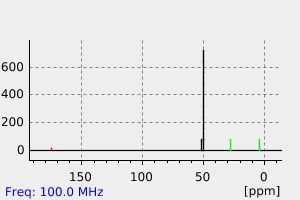2-(甲氧羰基)乙基三甲氧基硅烷 | 76301-00-3
中文名称
2-(甲氧羰基)乙基三甲氧基硅烷
中文别名
(三甲氧基硅基)丙酸甲酯
英文名称
Methyl 3-(trimethoxysilyl)propionate
英文别名
2-(Carbomethoxy)ethyltrimethoxysilane;methyl 3-trimethoxysilylpropanoate
CAS
76301-00-3
化学式
C7H16O5Si
mdl
MFCD08702779
分子量
208.287
InChiKey
XJLTZAGUXSAJCZ-UHFFFAOYSA-N
BEILSTEIN
——
EINECS
——
-
物化性质
-
计算性质
-
ADMET
-
安全信息
-
SDS
-
制备方法与用途
-
上下游信息
-
文献信息
-
表征谱图
-
同类化合物
-
相关功能分类
-
相关结构分类
物化性质
-
沸点:75°C 1,5mm
-
密度:1.069
-
闪点:>43°C
计算性质
-
辛醇/水分配系数(LogP):0.36
-
重原子数:13
-
可旋转键数:7
-
环数:0.0
-
sp3杂化的碳原子比例:0.857
-
拓扑面积:54
-
氢给体数:0
-
氢受体数:5
安全信息
-
TSCA:No
-
危险类别码:R10,R36/37/38
-
危险品运输编号:UN 1993
-
海关编码:2931900090
-
安全说明:S16,S26,S36/37/39
SDS
反应信息
-
作为反应物:描述:AuOH(1,3-bis(2,6-diisopropylphenyl)imidazol-2-ylidene) 、 2-(甲氧羰基)乙基三甲氧基硅烷 在 air 作用下, 以 甲苯 为溶剂, 反应 1.0h, 以80%的产率得到[N,N'-bis(2,6-diisopropylphenyl)imidazol-2-ylidene](2-(carbomethoxy)ethyldimethoxysilanolate)gold(I)参考文献:名称:有机硅烷的无氟重金属金属化成金摘要:黄金转移:多功能的金(I)配合物[Au(IPr)(OH)]可通过与适当的硅烷试剂反应,非常直接地获得一系列芳基,乙烯基和烷基金硅烷醇盐。这些硅烷醇化物是无氟工艺中的关键中间体,该工艺导致有机硅烷净重金属金属化成金。DOI:10.1002/chem.201202299
-
作为产物:描述:甲醇 、 乙烯基三甲氧基硅烷 、 一氧化碳 在 dicobalt octacarbonyl 作用下, 以 乙腈 为溶剂, 160.0 ℃ 、6.86 MPa 条件下, 生成 Methyl 2-(trimethoxysilyl)propionate 、 2-(甲氧羰基)乙基三甲氧基硅烷参考文献:名称:The highly regioselective carbonylation of vinylsilanes摘要:The hydroesterification of vinylsilanes, catalyzed by transition-metal complexes, afforded both beta-silyl esters 2 and alpha-silyl esters 3 in high yield. The Pd(II) complex-catalyzed reaction showed high beta-regioselectivity, whereas the Co2(CO)8-catalyzed reaction showed high alpha-regioselectivity. Vinylsilanes which bore trialkyl-, diphenylmethyl-, dimethylethoxy-, trimethoxy-, diphenylfluoro-, and difluorophenylsilyl groups were regioselectively, and some cases regiospecifically, hydroesterified. Pd(II) complexes were also shown to be effective catalysts of the hydrocarboxylation of vinylsilanes. Hydrocarboxylation was beta-regiospecific and gave excellent yields of beta-silyl carboxylic acids. Reasonable mechanisms for the reactions are described.DOI:10.1021/jo00041a025
表征谱图
-
氢谱1HNMR
-
质谱MS
-
碳谱13CNMR
-
红外IR
-
拉曼Raman
-
峰位数据
-
峰位匹配
-
表征信息
同类化合物
(2-溴乙氧基)-特丁基二甲基硅烷
鲸蜡基聚二甲基硅氧烷
骨化醇杂质DCP
马沙骨化醇中间体
马来酸双(三甲硅烷)酯
顺式-二氯二(二甲基硒醚)铂(II)
顺-N-(1-(2-乙氧基乙基)-3-甲基-4-哌啶基)-N-苯基苯酰胺
降钙素杂质13
降冰片烯基乙基三甲氧基硅烷
降冰片烯基乙基-POSS
间-氨基苯基三甲氧基硅烷
镓,二(1,1-二甲基乙基)甲基-
镁,氯[[二甲基(1-甲基乙氧基)甲硅烷基]甲基]-
锑,二溴三丁基-
铷,[三(三甲基甲硅烷基)甲基]-
铂(0)-1,3-二乙烯-1,1,3,3-四甲基二硅氧烷
钾(4-{[二甲基(2-甲基-2-丙基)硅烷基]氧基}-1-丁炔-1-基)(三氟)硼酸酯(1-)
金刚烷基乙基三氯硅烷
酰氧基丙基双封头
达格列净杂质
辛醛,8-[[(1,1-二甲基乙基)二甲基甲硅烷基]氧代]-
辛甲基-1,4-二氧杂-2,3,5,6-四硅杂环己烷
辛基铵甲烷砷酸盐
辛基衍生化硅胶(C8)ZORBAX?LP100/40C8
辛基硅三醇
辛基甲基二乙氧基硅烷
辛基三甲氧基硅烷
辛基三氯硅烷
辛基(三苯基)硅烷
辛乙基三硅氧烷
路易氏剂-3
路易氏剂-2
路易士剂
试剂Cyanomethyl[3-(trimethoxysilyl)propyl]trithiocarbonate
试剂3-[Tris(trimethylsiloxy)silyl]propylvinylcarbamate
试剂3-(Trimethoxysilyl)propylvinylcarbamate
试剂2-(Trimethylsilyl)cyclopent-2-en-1-one
试剂11-Azidoundecyltriethoxysilane
西甲硅油杂质14
衣康酸二(三甲基硅基)酯
苯胺,4-[2-(三乙氧基甲硅烷基)乙基]-
苯磺酸,羟基-,盐,单钠聚合甲醛,1,3,5-三嗪-2,4,6-三胺和脲
苯甲醇,a-[(三苯代甲硅烷基)甲基]-
苯并磷杂硅杂英,5,10-二氢-10,10-二甲基-5-苯基-
苯基二甲基氯硅烷
苯基二甲基乙氧基硅
苯基二甲基(2'-甲氧基乙氧基)硅烷
苯基乙酰氧基三甲基硅烷
苯基三辛基硅烷
苯基三甲氧基硅烷







